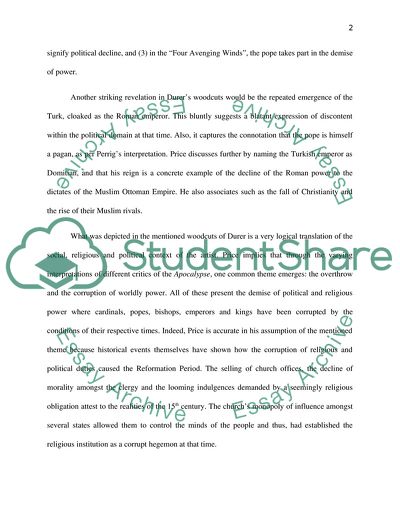Cite this document
(A Synopsis of David Prices Albrecht Durers Representations of Faith: Article, n.d.)
A Synopsis of David Prices Albrecht Durers Representations of Faith: Article. https://studentshare.org/social-science/1771319-synopsis-of-the-argument-from-the-article-david-price-albrecht-drers-representations-of-faith-the-church-lay-devotion-and-veneration-in-the-apocalypse-1498-zeitschrift-fr-kunstgeschichte-574-1994-pp-688-696
A Synopsis of David Prices Albrecht Durers Representations of Faith: Article. https://studentshare.org/social-science/1771319-synopsis-of-the-argument-from-the-article-david-price-albrecht-drers-representations-of-faith-the-church-lay-devotion-and-veneration-in-the-apocalypse-1498-zeitschrift-fr-kunstgeschichte-574-1994-pp-688-696
(A Synopsis of David Prices Albrecht Durers Representations of Faith: Article)
A Synopsis of David Prices Albrecht Durers Representations of Faith: Article. https://studentshare.org/social-science/1771319-synopsis-of-the-argument-from-the-article-david-price-albrecht-drers-representations-of-faith-the-church-lay-devotion-and-veneration-in-the-apocalypse-1498-zeitschrift-fr-kunstgeschichte-574-1994-pp-688-696.
A Synopsis of David Prices Albrecht Durers Representations of Faith: Article. https://studentshare.org/social-science/1771319-synopsis-of-the-argument-from-the-article-david-price-albrecht-drers-representations-of-faith-the-church-lay-devotion-and-veneration-in-the-apocalypse-1498-zeitschrift-fr-kunstgeschichte-574-1994-pp-688-696.
“A Synopsis of David Prices Albrecht Durers Representations of Faith: Article”. https://studentshare.org/social-science/1771319-synopsis-of-the-argument-from-the-article-david-price-albrecht-drers-representations-of-faith-the-church-lay-devotion-and-veneration-in-the-apocalypse-1498-zeitschrift-fr-kunstgeschichte-574-1994-pp-688-696.


